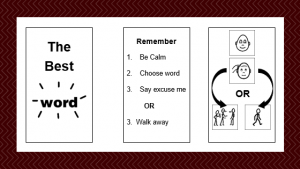***Free resources at the end of the post***
Profanity in the classroom can be a tough behavior to deal with. If you teach in middle or high school and you have a student who walks into your classroom throwing the f-bomb or other words that would not be considered so nice then what are you to do? Perhaps the student is looking for that shock value. Perhaps he/she is just super frustrated and has no better way to express himself/herself. Although it is critical to figure out the WHY, for now you just need the profanity to STOP.
Now imagine that this student has been using profanity in the classroom for years. No one has ever really addressed it before. Or, they tried but were not all that successful. Now you not only have a student who uses profanity but one who may have been doing it for the last 10 years. How in the world can you ever get that to stop?
There is no magic bullet to get students to stop ANY learned behavior that is quick and easy including using profanity in the classroom. You need to commit right up front that you are in it for the long haul. You need to be realistic, and accept that the first, second, and third plans may fail. But, you know it will somehow stop with you. If you are willing to put in the work, take the time, and investigate the root cause, you will be successful. And, although later teachers won’t thank you, because you cannot really appreciate a bad behavior that is no longer present, you will have the satisfaction of improving the social acceptance and ultimate quality of life on this one student. Stopping the use of profanity in the classroom will be so worth it.
Dealing with profanity in the classroom: a plan
- First, you need to determine with as much certainty as possible what is causing the student to use profanity in the classroom. I always found it helpful for someone else to come in and do an observation or functional behavioral analysis. Sometimes, I even videotaped the student so I could get a second opinion (with permission of course). Absolutely no plan will be successful if you cannot truly define the reason behind the behavior. Let’s look at some potential functions of using profanity in the classroom:
- Escape. Many students use negative behaviors to get out of a situation. They learn that if they throw out certain words, adults will do almost anything to get them to stop. The adult will take away the demand. The adult will give a reinforcer freely. The student will be showered with attention to hopefully stop those awful words from spewing forth. (Read more in a blog post all about dealing with escape behavior.)
- Attention. Yep, this is the most common reason. Certain words have amazing shock value when used in a classroom setting. The gasp from adults is almost involuntary. The attention adults give is immediate, not to mention the attention of everyone in hearing distance. It can be really, really hard to NOT give this behavior the attention it often demands. (Read more in a blog post all about dealing with attention-seeking behaviors.)
- Gain access. This is similar to the function of escape. As often happens, when students cannot get access to what they want, they pull out the negative behaviors to not only show their displeasure but because in the past, it has been a way for them to regain access to that desired item. Using profanity is no different, and is often used as a tool to get adults to just give in. (Read more in a blog post all about dealing with denied access, a common behavior problem.)
- Internal/self-reinforcing. So some behaviors, although not many, occur simply because it feels good to the individual, or it is beyond their control. Tourette’s syndrome is a good example of this. Too often, we choose this function because we just don’t know why the student is choosing this negative behavior. I have even pulled this card myself a few times. I swear the kid “just does it” for no reason. Inevitably, I am proven wrong. So use caution if this is the function you land on.
- Get a baseline. So before jumping in with some grand intervention plan, get a baseline first.
- How often does student use profanity
- Where is it most often used?
- What particular words are most often used and how often
- Get a super clear picture of the entire scope of the behavior. This will be so helpful when trying to choose a replacement for the profanity.
- What is happening right before the swearing begins? Does the student take a deep breath? Does the student clench his or her fists?
- This is different than the antecedent. We are not looking for what may trigger the behavior, just what is the first physical sign it is about to occur.
- How long does the actual cursing typically last? You could measure this in either words or seconds. What is his/her face look like? Are the eyes open? Does the face get red? Is their involuntary spitting involved?
- What happens right after the student is done swearing? Does he/she take a deep breath? Is there a slight smile? Where do they look? At you for a reaction? Out into space as though he/she is emotionally spent?
- Come up with a replacement behavior. Here is the hard truth. Punishing a learned behavior, even a negative one, rarely makes it go away. We cannot just somehow force the student to stop swearing. We need to give them something to do instead, and it needs to look and feel as close to the real thing as possible. This is why clearly identifying when the behavior is about to start is so critical. We want to come in with a replacement BEFORE the cursing actually begins. We want to interrupt the cycle just as it is starting. Above all, we do not want to inadvertently reinforce the swearing by coming in too late with some “cool” alternative. It may take you a while and some brainstorming to come up with something good. So what are some possibilities?
- Choosing a more socially acceptable word.
- Handing the student a stress ball or other sensory object (or maybe it is in their pocket).
- Pounding their fist into the palm of their hand.
- Coming up with a “cool” hand signal, that you and the student agrees on means “that word.”
- As soon as you see that first sign, jump in with whatever replacement you have chosen. Use whatever prompt you feel is most appropriate, be it a flashcard, a picture, a gesture, or a verbal prompt. IF the student uses the replacement behavior then he/she gets the result of whatever the identified function was. Maybe he/she wants to get out of doing work, maybe he/she gets some super cool reinforcer, or maybe he/she just gets a bucket-load of attention (in a really big way). Whatever the result, it has to be worth it. The replacement has to seem better than the original profanity choice.
- Communicate the plan to everyone and make sure parents are on board. Make sure as many people as possible truly understand this plan. There is nothing worse (or stronger) than intermittent reinforcement. So if everyone follows the plan, and then at dismissal when it is getting crazy, and your assistant decides to go back to just trying to punish the behavior it will be a disaster. If you fail to interrupt the pattern and don’t get a chance to use the replacement behavior, it is better to simply ignore the entire cycle. Give it no attention, and just proceed as if the profanity never occurred.
- Teach, teach, teach. The plan you come up with should NOT be a secret from the student. This is a team approach, not some stealthy mission to eradicate bad words. So, talk it out. Allow the student to make some choices if possible. Then, deliberately practice and teach the plan. You can introduce social stories or power cards into the mix if that is helpful. (You can download some FREE power cards at the end of this post to help with choosing the best word.) But, really the key is a commitment on your part to take focused time every day to work on this skill.
- What if it totally fails? Well, to be quite honest, it probably will a few times. I don’t think I have ever come up with a behavior plan that worked out of the gate. Don’t give up!! Persevere, it will be worth it. If you have older kids, this behavior may be years old. The learned patterns run DEEP. This is where that baseline data can be helpful. Not sure if your plan is working at all? Re-take some of that data you took in the beginning WITH the plan in place. We should always be making decisions based on data if at all possible.
- Watch out for that extinction burst. So, with any good behavior plan, the targeted negative behavior is likely to get worse before it gets better. Be prepared for it, and make sure the other people are ready for it as well. Nothing will derail a plan faster than watching a kid who was swearing a couple of times a day, all of a sudden start swearing multiple times a day. The introduction of the replacement behavior will help keep this at bay, or could even squelch it all together. I have had that happen too. A really good replacement behavior with consistent intervention can really decrease or even eliminate that burst.
I know profanity in the classroom is a hard thing to deal with. I know you may get a lot of push back from other parents and administrators for not having an immediate and stern consequence. But I applaud you for your effort. I applaud you for choosing to go with research rather than gut instinct. It may feel like you will never get there (it once took me 3 years to replace a behavior successfully with one of my students), but just keep trying. Later teachers may not thank you, but it will make a huge impact in the social life and community acceptance of that student.
Dealing with profanity in the classroom: resources
Need some help getting started? I have a unit I put together with 2 social stories, activities, and power cards. You can check out my unit on Cursing in the classroom for more help.
Free Power Cards
Just need some power cards for dealing with profanity in the classroom for now? You can download them for FREE by clicking on the button below.




One Comment
Comments are closed.